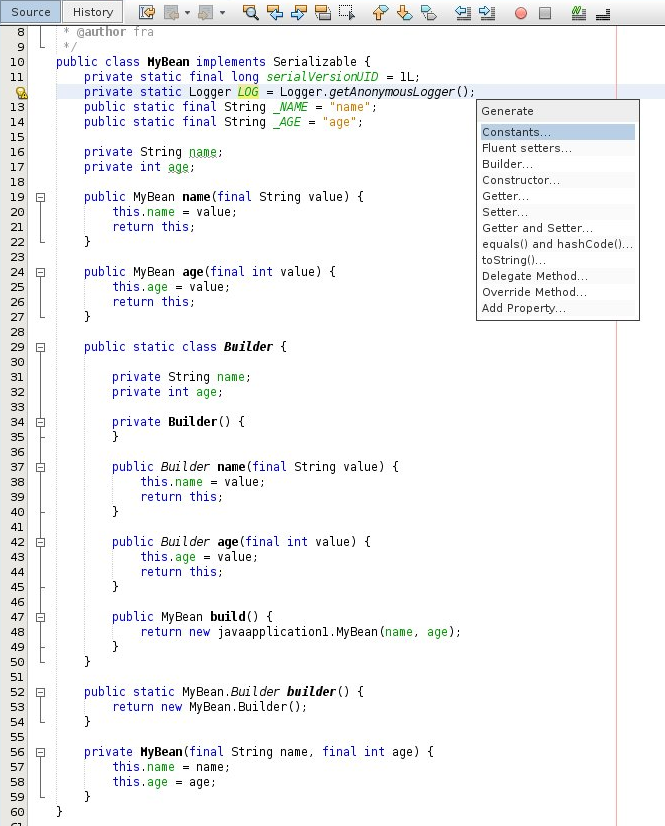-
12.3 2021-03-14 adapted to netbeans version 12.3. Version name changed to reflect that.
-
3.2 2020-09-24 migrated to a maven project in order to be published
-
3.1 2020-09-23 fixed java.lang.LinkageError (conflict with nb-javac plugin)
-
3.0 2020-07-28 Added:
- fluent setters using withName()
- copy constructor
- updated to latest API
-
2.0 2014-07-22 (was externally named 1.0)
-
1.0 First version
The plugin can be downloaded from the Netbeans Plugin Center.
Accessing fields via reflection is risky because string names cannot be enforced to match the fields they refer to. To mitigate this problem an automatic procedure can be used to auto-generate them. The constants start with an underscore so to allow the automatic removal of removed or changed fields. The underscore can also be useful to implicitly specify that the constant refers to a field name.
public static final String _FIELD_NAME = "fieldName";
private int fieldName;Fluent setters are field setters that return this and so can be appended one to another:
public NamedBean name(final String value) {
this.name = value;
return this;
}The previous setter can be used like this:
NamedBean nb = new NamedBean().name("Some Name");This methods allows for a better understanding of the class initialization parameters but it cannot be used with immutable classes.
A different naming for fluent setters use the 'with' prefix so that the previous name(String) method would be called withName(String). This is useful with IDE that allows browsing available methods to quickly find fluent setters by just typing the prefixed 'with' (from version 3.0+).
A builder is a separate class uses a fluent interface to generate another class (can be used with immutable classes as well).
This is an example of a builder as created by the plugin:
public class MyBean {
private static String pippo = "";
private final int a = 1;
private String name;
private final int age;
public static class Builder {
private String name;
private int age;
private Builder() {
}
public Builder name(final String value) {
this.name = value;
return this;
}
public Builder age(final int value) {
this.age = value;
return this;
}
public MyBean build() {
return new javaapplication1.MyBean(name, age);
}
}
public static MyBean.Builder builder() {
return new MyBean.Builder();
}
private MyBean(final String name, final int age) {
this.name = name;
this.age = age;
}
}Note that the initialized final field is not considered in the builder. The generators can also be used while refactoring because they remove automatically the old artifacts and replace them with the new version.
Adapted from the original Netbeans project using the guide at: https://netbeans.apache.org/wiki/DevFaqMavenHowToMigrateFromANT
published to maven central and on the netbeans plugin repository following the guide at: https://cwiki.apache.org/confluence/display/NETBEANS/Step+by+step+guide+for+upload+NBM+to+Maven+Central
Use Netbeans to execute 'mvn clean install' so to be able to provide the needed passwords and then execute manually: 'mvn deploy' .
Check if it is deployed by using: https://oss.sonatype.org/#nexus-search;quick~com.fillumina
